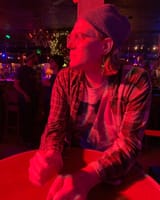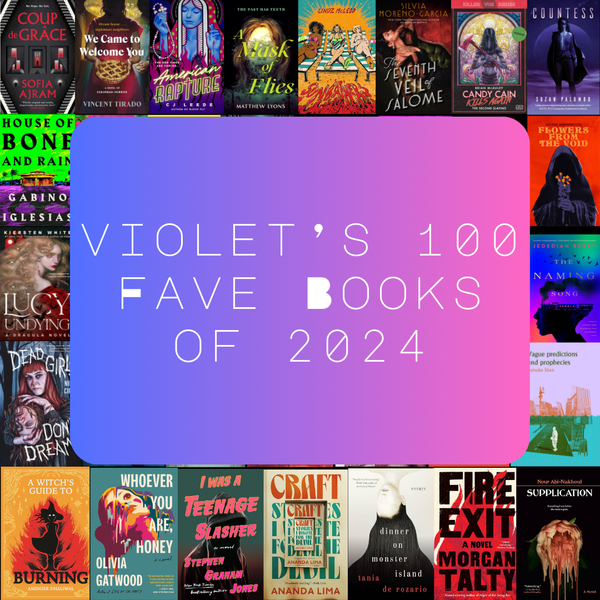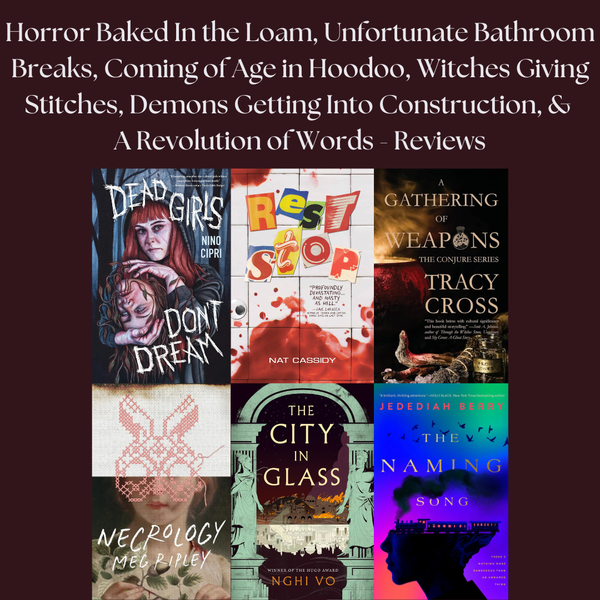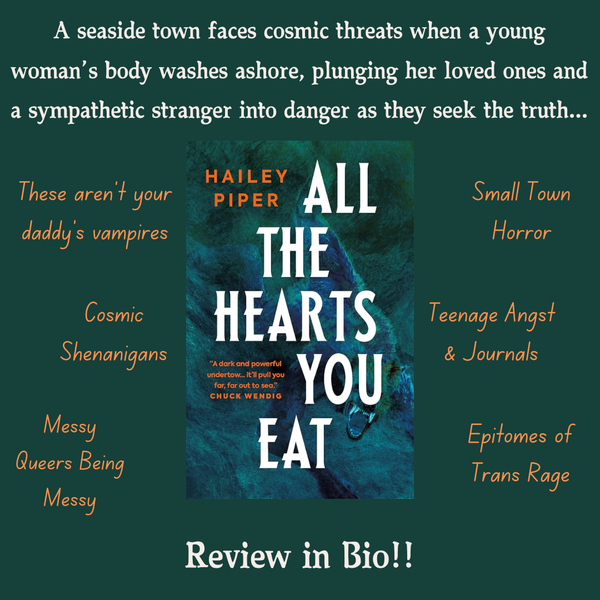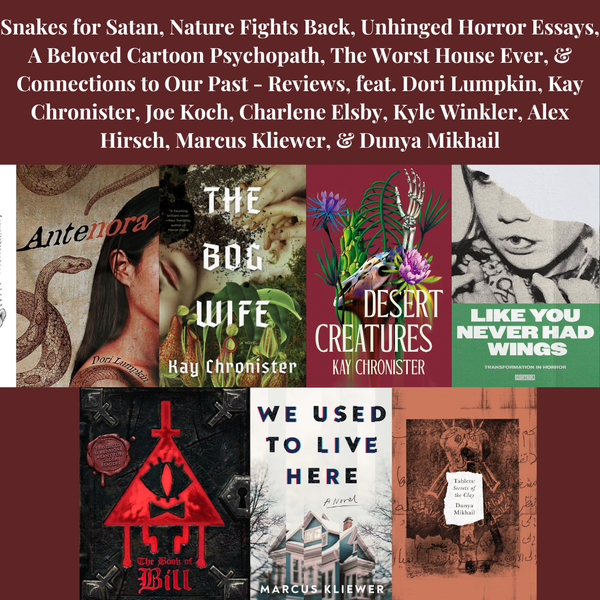Your Summer TBR is Calling, And Mama Vi is Here to Help!
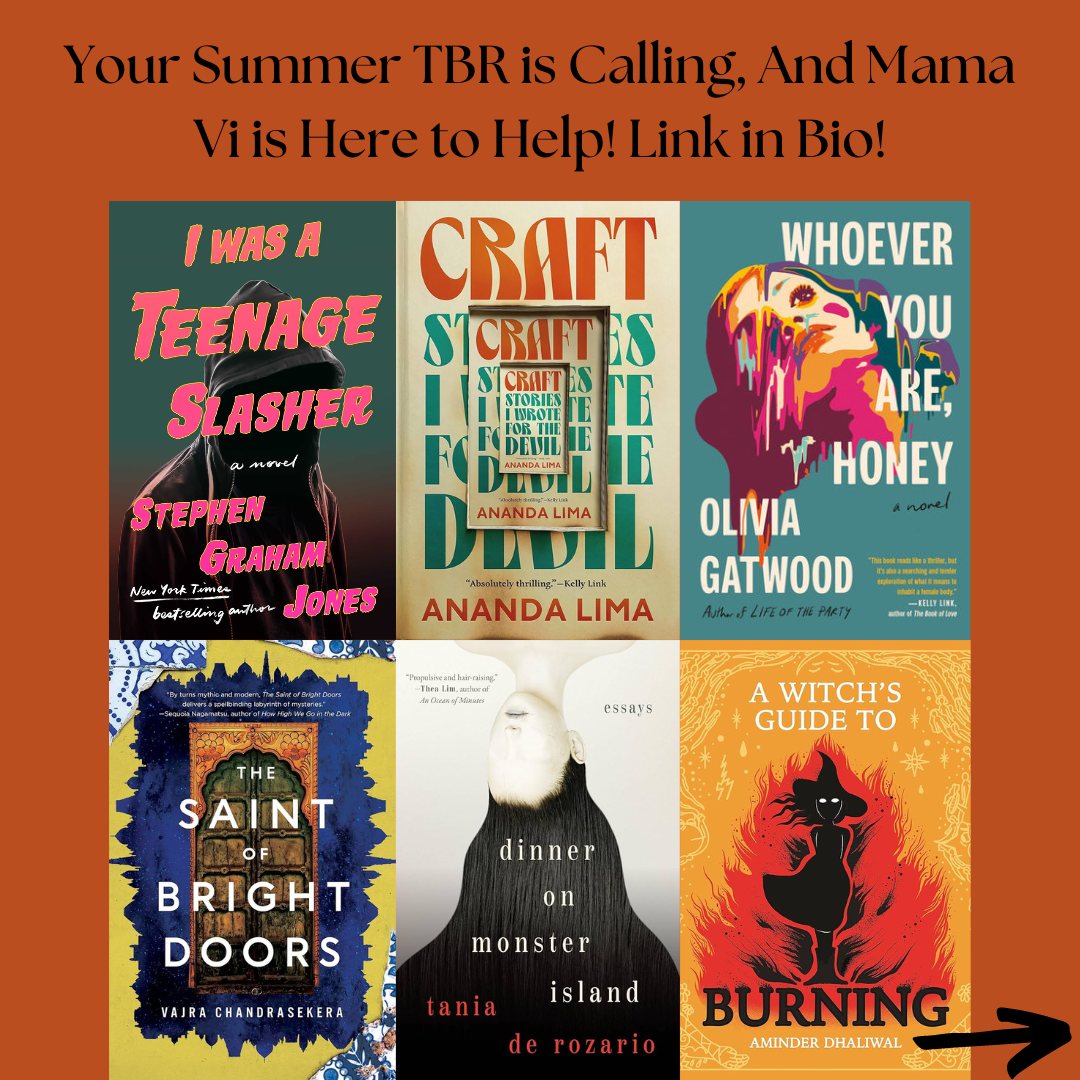
Ohhhhhhhhhhh, mama is SO behind on reviews!! As I'm sure most of you have seen over the last month I had been gearing up for our Dark Ink event at Doylestown. I'm still reeling from the success of the day and I thank everyone whose been sharing their experiences and engaging with all of us. It is a dream.
This summer has been positively PACKED with excellent releases, and this will highlight some, as well as ones from earlier this year that I missed!
I Was a Teenage Slasher by Stephen Graham Jones, Saga Press
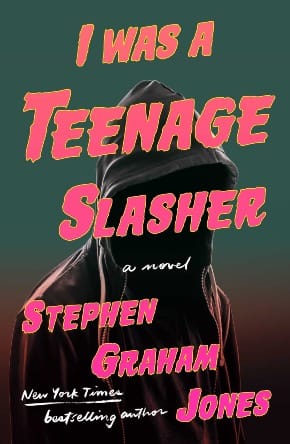
Though it may sound strange for a rabid Stephen Graham Jones fan to say they are pleasantly surprised by a novel of his, allow me to explain.
Being that 2024 marked the close of his epic Indian Lake trilogy, the last few years of SGJ have been slasher-ific. When I Was a Teenage Slasher was announced, I promptly cursed him as I curse all these wildly talented writers that release like...a billion books in a year. How do they do it? How may I harness these uncanny abilities??
James Patterson is an extreme exception because he doesn't write even half of this books. Besides, he's in time out for ruining a Michael Crichton manuscript.
ANYWHO, my second response to this news was, "Really, Stephen?? Another slasher??" But I knew in my heart of hearts that in his hands, any slasher has the ability to surprise me. The Indian Lake trilogy alone completely changed the game over the past few years.
When I finally did park my keister to dive into this newest slice of Jones surrealism, I found myself hooked from the get go. Told from the neurodivergent diaries of young Tolly Driver, we watch as his burgeoning career as an upcoming slasher come to be. However, I was in no way prepared for how SGJ would subvert the genre in this adventure.
Ringing similarly to tales like Paul Tremblay's The Pallbearers Club, Teenage Slasher deconstructs the subgenre as much as it plays by its rules, in only the ways a man with encyclopedic knowledge of its trappings can. In doing so, Tolly introduces us to a character that in many ways reflects Jones's upbringing in Lamesa, West Texas, but additionally shines the spotlight on the many complexities and mistakes of youth. Where one might expect to harbor a certain degree of ill-will toward someone rapidly encompassing the life of a slasher, Tolly captures your heart in disarming ways, setting up one of the most compelling horror villains of 2024.
There's also much to say of Jones's interweaving of themes of white supremacy/white guilt, toxic masculinity, legacies, grief and so much more. When we meet Tolly, he's recently lost his father, barely being held together by the care of his closest friend Amber Big Plume Dennison, who this entire diary is being written to. Amber is the absolute standout of this novel, not solely due to her status as a capital "B" Badass, but also as the emotional and thematic crux to which Tolly oscillates.
What sets events into motion is a fated party at the house of who we're led to believe is our stories "final girl," Stacey. In the classic way teenage films play out, Tolly is singled out for cruel punishment from the cheer team as he's tied to a pool chair and made to drink Coke with peanuts snuck in. Being that Tolly has a peanut allergy, this sends him into an extreme episode that only concludes when Stacey grabs his EpiPen and is able to bring him from the brink of death.
No sooner is one crisis averted that another comes screaming into the backyard. The resurrected corpse of a student who died several years prior is back for revenge on the peers who got him killed at the local oil pumpjack. Upon witnessing this bloodbath, Tolly and Amber are just narrowly able to escape, and it is from here that the tragic unraveling begins.
I've cried reading SGJ before. Listening to The Only Good Indians back in the earliest days of Covid caused a half hour sob-session. But boy oh boy, when I tell you I was not prepared for the ending of this novel, I speak not in hyperbole. Tolly's and Amber's stories reflect a heartbreak that is often felt in the crumbling of a friendship, or any kind of relationship. That very real psychic pain that you feel long after the connection has severed.
I don't want to delve into it any further, but I will say this: I Was a Teenage Slasher is a marvelous conclusion (for now) to the last few years of slasher goodness that SGJ has cooked up for us with his devious mind. I'm excited to see what he does with vampires next year, but to have this be the final in a string of slasher-themed exorcisms for his soul, it absolutely feels like the perfect curtain call for a hyperfocus. As always, well done Mr. Jones.
Craft: Stories I Wrote for the Devil by Ananda Lima, TOR Books
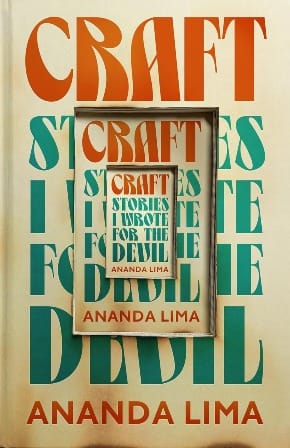
The first of two fiction debuts from poets I love in this list, we have Ananda Lima's poised, yet daring collection of interconnected stories, Craft: Stories I Wrote for the Devil. You can decide to read "Devil" in Matt Berry's voice if you so choose.
I first came to read Lima a few years ago when reading about the best poetry of 2021 and devoured her stunning collection, Mother/land. If you had told me 2024 would see a book of fiction from this wildly talented writer, I'm not sure I'd believed you, but Craft certainly delivers in many of the ways her previous poetry has.
Centered around a Halloween party in the 90's, a writer finds herself in a fateful exchange with the Devil, whose costume description is very much Donald Trump. When asked about his costume, he merely responds that he's "the future." This Devil is also painfully aware of how his deeds and lives have been completely misconstrued by a people who needed a villain within their religion. After charming conversation and a few drinks, the two part, but this is only the beginning of the writer's story...
What follows are tales that perfectly blur the line between reality and a form of magical realism. With each page, we witness how wholly a writers work is effected and amplified by their singular craft (waits for applause and cheering to die down). In all seriousness, Lima very carefully obscures the boundaries of story and self as the writer witnesses the world rapidly change around her, mirroring her anxieties and fears within the real world. All the while the Devil continues to visit her for in-depth conversations, as well as intervention when she finds herself at stand-stills.
While these stories aren't necessarily horror in its scariest sense, the slow-building tension of a world falling to fascism, climate catastrophe, and, yes, Covid, provides a playground in which Lima can tinker with genre expectations. In the spirit of many of our most beloved speculative fiction writers, she's able to gracefully inhabit various genres, all while breaking their conventions every step of the way.
Offering a rewardingly pensive and introspective experience, Craft is not going to scare you in the ways we typically expect of a horror, but it will wind its way around your brain and hold there long after you close its final pages. If you love poetry, I highly recommend Mother/land, as it pairs so perfectly with the enduring themes of identity and immigration throughout Lima's work.
Whoever You Are, Honey by Olivia Gatwood, The Dial Press
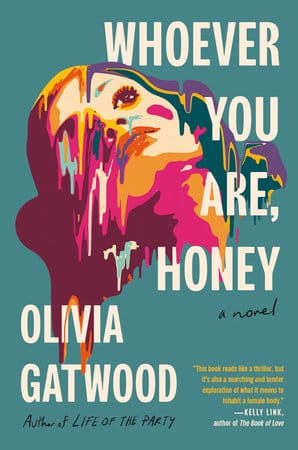
Olivia Gatwood is one of the most exciting poets/writers of our time. As a massive fan of her previous poetry collections—2017's New American Best Friend and 2019's Life of the Party—I was screeching like a little banshee when I saw the announcement of her debut novel, Whoever You Are, Honey.
Featuring the fierce voice apparent throughout her work, this literary tale of friendship, obsession, queerness, and mental health is a deep-dive into not only the complexities of contemporary womanhood, but the ways in which femme bodies continue to fight for autonomy in a landscape–both human and tech–seeking new ways to control them. We're introduced to Mitty, a woman who lives on the Santa Cruz shorelines with her elderly friend Bethel. This area was previously untouched by the excess of Silicon Valley, but with the building of an exquisite new house owned by tech-founder Sebastian and his partner Lena, Mitty finds herself fixating on Lena, as well as the couple's dynamic.
Lena struggles with memory issues, and finds herself drawn to Mitty and Bethel, eventually confiding in Mitty about these issues. As the book unfolds, we learn more about Mitty's own past, including how she came to live with Bethel, as well as a traumatic rejection of her queerness, causing an event that altered her life forever.
The connection between Lena and Mitty continues to grow until a heartbreaking, almost surreal climax, bringing the topics of femme autonomy full circle in ways that leave you analyzing the first 200-some pages you've already read. Gatwood perfectly leaves the ending ambiguous and open-ended, leading readers to question reality itself, or rather, further investigating the structures affecting our lives every day.
With shades of thriller and science fiction, Whoever You Are, Honey is a modern masterpiece that upholds the fight for women and femmes to find and attain autonomy from the people and structures whose obsessions with control continue to harm us all. Unsurprisingly, this has become one of my favorite books of the year.
The Saint of Bright Doors by Vajra Chandrasekera, TOR Books
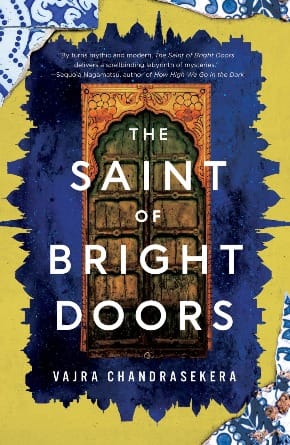
As the news surrounding Neil Gaiman's horrific misconducts continue to worsen in the news, I offer you a stunning alternative that not only utilizes much of the conventions Gaiman highlighted in his fiction, but actively subverts them as well.
Vajra Chandrasekera's The Saint of Bright Doors delivers similar vibes as Gaiman's classic, Neverwhere, but what it does with those vibes critiques much of the pitfalls and upholding of empire that's persisted throughout fantasy for the past 20 years. We follow Fetter, a person whose childhood only knew violence, training as a weapon under the watchful eye of his mother, and in reaction to his father, a charismatic cult leader whose movement successfully sweeps through much of the world.
Once he comes of age, Fetter abandons home for the big city of Luriat, where he finds the Bright Doors, a series of doors that open to spaces unknown, but blast forth cold air when opened. As he moves throughout the society of the city, he meets revolutionaries, heads of empire, and gods and deities that exist amongst the mortals they deride. All the while, his father and the cult worshipping him seem to draw ever nearer to Luriat itself. It would appear that destiny has come knocking–how will Fetter answer?
While much of this novel is structured within fantastical realms, there is a compelling drama and political intrigue at its center. Fetter boasts his own complexities as he struggles with the traumas of his childhood, attempting to actualize the kind of person he hopes to be. No matter what, he's still bumping up against humanity, and as the novel comes to a close, we witness a drastic left turn in narrative, driving home the novel's ultimate tragedies.
Complex, dark, and gloriously realized, The Saint of Bright Doors is a contemporary fantasy classic from a unique voice setting a whole new standard in how to explore humanity amidst fantastical themes.
Dinner on Monster Island: Essays by Tania De Rozario, Harper Perennial
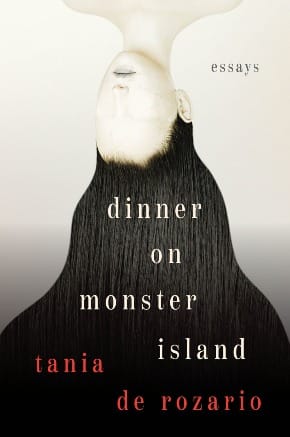
There has been a plethora of memoirist writing that engages with the horror genre recently. Joining these groundbreaking ranks is Singaporean writer and visual artist Tania De Rozario, whose debut essay collection Dinner On Monster Island released at the beginning of this year.
Utilizing her love for the genre, De Rozario looks back at how themes of the monstrous feminine, as well as fatphobia and conservative repression in Singaporean culture have effected her life and sense of self. Analyzing films such as Carrie, The Ring, and The Witch, we learn of her childhood, where at the age of 12 her friend attempted a "gay-exorcism" upon her. Through many of these films, De Rozario is able to find strength and resilience in a world that seeks to diminish her.
Just as enlightening as the cultural criticism, her engagement and detailing of the history of policy in Singapore from the late 80's and throughout the 90's presents its own form of historical and sociological insight. Specifically the section describing the incredibly fatphobic policies that pervaded the 90's, as they did in the US as well.
Defiant, empathetic, and brazen, Dinner On Monster Island is a vital piece of cultural criticism for horror and essay fans alike. De Rozario's voice is clear and fierce, providing a story that is hopeful and resilient in the face of a world hell-bent on breaking those who don't fit the molds of white supremacy.
A Witch's Guide to Burning by Aminder Dhaliwal, Drawn & Quarterly
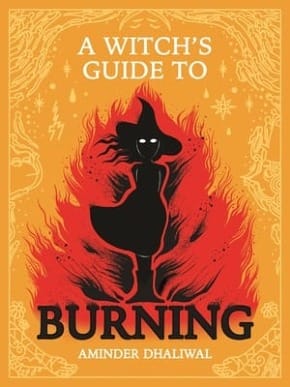
From one of my favorite illustrators in the game, Aminder Dhaliwal, comes an epic fantasy adventure that revolutionizes the witchcraft subgenre to tell a story of resilience in the face of violence, as well as embracing identities perhaps beyond those that may harm us in the long run.
A Witch's Guide to Burning follows Singe, a witch who awakens following her burning at the stake in her village, awakening to the arrival of another witch, Yew-Veda, and her companion Bufo, a powerful wizard who trapped himself in the form of a toad. These unlikely friends seek to help Singe remember who she is, as well as healing her magical powers so that they may defend themselves from the manifestations of Singe's doubt, shame, and more.
To say that this 400 page graphic novel epic is rich with world-building feels slightly disingenuous, as Dhaliwal's ambition and creativity shines in ways most contemporary fantasy authors eschew for spectacle. Every piece of lore, magic, and Signe's history is crafted with such meticulous detail, you find yourself completely wrapped up in splendor of it all. These features, coupled with her signature art style, crafts a classic that feels equal parts familiar and wholly original.
The artists signature wit is never far behind either, considering that Women World and Cyclopedia Erotica were both delightful satires in their own right, but this book boasts its own drama and heart, consistently building upon Singe's story, confidence, and personal power as she faces past and present dangers and betrayals. We are introduced to towns that see the burning of witches as a means of sacrifice for food and sovereignty, forming its own dilemma within Singe as she yearns to return to what she thought was the safety of home.
Perfect for fans of fantasy and graphic novels, A Witch's Guide to Burning is exactly what you need to get out of a reading slump, or simply want to get lost in an extraordinary land of characters you'll never cease celebrating.
Corpses, Fools, and Monsters: The History and Future of Transness in Cinema by Willow Maclay & Caden Gardner, Repeater
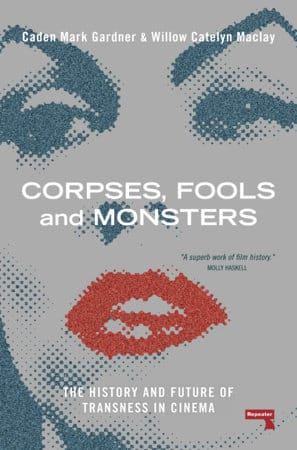
As it states on its tin, this landmark piece of trans film history comes by way of Candian writers/theorists Willow Maclay and Caden Gardner. Similar to the fantastic works of Jules Gill-Peterson and Tre'vell Anderson, these authors seek to chart as linear of a timeline as they can when it comes to what they've deemed the, "trans film image," widening the scope of how gender creativity has been distilled in the history of film.
Ranging from salacious documentary, to massive blockbuster tentpoles, any queer or trans cinephile will find much wealth of information in its pages. Of course, the usual suspects are here: The Matrix quadrilogy, Silence of the Lambs, Sleepaway Camp, The Danish Girl, however, there is a wealth of perhaps not as well-known films in discussions of Tashio Matsumoto's Funeral Parade of Roses, Rainer Werner Fassbinder's In a Year of 13 Moons, and Tourmaline's stunning Salacia, to name a standout few.
Maclay and Gardner also present documentaries that exist outside of the landmark Paris Is Burning, which remains a classic of queer, trans, and gender creative representation, but is often mistaken as one of the only documentaries from that time that reflected said representations. What follows is a gorgeously in-depth tapestry of various genres and films that reflect the good, bad, and endlessly complex history of trans images in film. For every success, there is another exploitation, but as we near the present day, we witness the growing field of trans filmmakers changing how trans art is not only made, but shared and told as well.
Tourmaline is an excellent example, as is contemporary indie darling Jane Schoenburn, Alice Maio Mackay, and many others. These directors are changing how we ingest trans cinema, and it leaves the book on an incredibly hopeful note, as we see more and more trans filmmakers carve their way into the indie and mainstream market. If you have any form of interest in the subject of trans film and art, this is absolutely a work you should have on your radar. This is the debut of two voices that will take film criticism by storm.
Vague Predictions & Prophecies by Daisuke Shen, CLASH Books
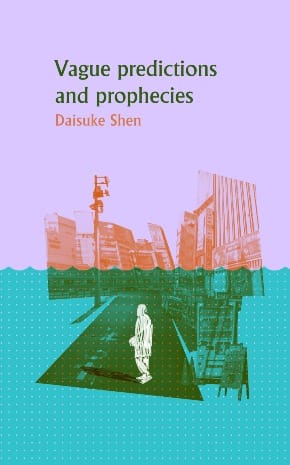
Quite possibly one of the best speculative fiction story collections I've read in my entire life, Japanese-American writer Daisuke Shen debuts their haunting creations in an upcoming release with blog-favorites, CLASH Books.
Vague Predictions & Prophecies is a sprawling genre-feast, delivering tales that are terrifying, existential, and ingeniously clever. There is heart at the center of every single one of these stories, so that even in the darker or non-human stories, humanity is ever-present as a tool to help us understand these creatures, machines, what have you.
From clones made to look and act exactly like your partner secretly drugging you to make you forget they're the clone, to a group of four boys attempting to have some fun with a field of human female scarecrows, there is no limit to Shen's imagination as they explore desire as a means of structure and destructor as characters face all manner of trial and tribulation throughout.
It's difficult to describe the stories without spoiling many of them, but I must say that there were several times my jaw hit the equator reading this book. Each story is presented in a matter-of-fact way, leaving you completely blindsided when whatever unnatural entity or happenstance rears its head. It's a world that is so much our own but also something completely new and unexpected that will have you chuckling, screaming, and crying in equal measures.
I cannot recommend a story collection more, as these are the kinds of works that make speculative fiction what it is, offering something familiar and unique simultaneously. This comes out next week, 08/13, and you bet your bottom dollar this will be on Lahaska's shelves.
(I say that with confidence because our copies already came in and wait patiently in the back room hehe)
Letters to the Purple Satin Killer by Joshua Chaplinsky, CLASH Books
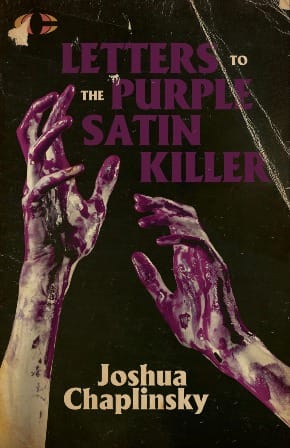
Another delightful CLASH romp, Letters to the Purple Satin Killer tells the morbid yet hilarious tale of Jonas Williker. Jonas was a serial killer hailing from this here Keystone state of Pennsylvania, committing brutal acts of murder and leaving the calling card of a piece of ripped purple satin on the body of every victim.
The book is set up as a compilation of letters sent to Jonas while he was in prison, leading up to the trial, and then concluding around the time of his execution by lethal injection. We're told in the forward that his responses have been withheld so as to paint a portrait of the human condition within the early to mid-00's, as technology and our appetite for true crime began to shift to something maybe a little darker than we initially imagined...
There is a large cast of characters in this book including Jonas's mother, his ex-wife, a student who winds up developing a sexual connection with him, becoming his wife, and then having a child with him, and even a woman who forms a fairly obsessive friendship with him despite never meeting the man in real life. There are also correspondences from younger children, his first daughter, and even pastors and children of pastors.
Within this framing, we see a story unfold that is simultaneously disturbing, heartbreaking, and hilarious, as Chaplinsky holds to mirror to our society and this never-satiated appetite for violence and true crime. Being that we never hear Jonas's side of the letters, the arcs that we follow shift and change without the input of the serial killer himself, leaving out a key component of speculation, yet retaining the speculation of the letter writers themselves.
Some of the funniest moments appear when collectors or sellers of horror/serial killer memorabilia write to Jonas, trying to make deals for things that they could put up and sell from his belongings, ignoring the horror of his crimes entirely. There is a black metal musician who strikes up a friendship with our titular killer, appearing to have a heart of gold, yet completely missing the context of Jonas's crimes.
While this book is ultimately a tale of how humanity consumes violence in American media and society, there is a truly heartbreaking undercurrent to its messaging. One character is a teenager who winds up sustaining a dangerous head injury and begins to feel uncontrollable rage. He writes to Jonas as a way of connection, not sure how to curb these feelings. As the correspondence goes on, you can only watch the train crash as it becomes clear our killer is feeding into the young man's desires, stoking the flames for further violence.
On the flipside, there are hopeful moments as well, as many characters come together in the midst of the outrage and violence. It paints a truly peculiar picture, though by design, and the moral whiplash you experience between each letter makes for a wild ride altogether. All said, it must be stated that this novel doesn't set out to answer any questions. It's not meant to solve any of these issues that we face within media literacy or our relationships to violence. It's a satire and does its job well. There's some uncomfortable topics, but nothing is ever handled in an exploitative or vicious way. There are moments of discussion where it's revealed that one of Jonas's victims was a trans woman, and being that the book is set between 2004-2009, there are some not super lovely mentions of this victim, but this is merely a means of highlighting the larger satire of humanity throughout.
Letters to the Purple Satin Killer is a deliriously grim novel, but if you enjoy serial killer stories with that satirical bent to them, then this is definitely a novel for you. be sure to check it out as it releases 8/06!
The Dissonance by Shaun Hamill, Pantheon
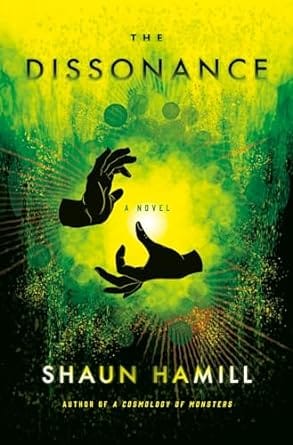
Honestly, one of the best blurbs I've read this year came from Gennarose Nethercott for the novel The Dissonance by Shaun Hamill:
That practically does my job for me, but I'd still like to share my thoughts regarding this fantastic contemporary dark fantasy.
Sold as a combination of The Magicians and Stephen King's It, I would venture even further to say this additionally pairs perfectly with Kelly Link's The Book of Love and Edgar Cantero's Meddling Kids. Four friends find themselves drawn into a world of stunning powers and horrifying creatures as they connect into the Dissonance, a form of magical power that's not quite magic. On a visit to their friend Peter's grandfather's house, Athena discovers a small book merely laying on the floor of a hallway. She discovers she can somehow understand the writing inside and sets out to try one of the spells with Peter, Erin, and Hal. Following the success of causing Hal to levitate, everything goes to hell as they encounter dangerous spider-like creatures out in the woods, responsible for the disappearance and then brutal death of a missing boy from their school.
It is then that grandfather Marsh is forced to teach them more of the Dissonance's powers, as it is clear that all four have immense gifts. The It comparisons refer to this narratives switching between the present, where the kids are now in their mid-to-late 30's, separated and clearly traumatized from their experiences, and the fateful summer in which they discovered these powers, undergoing strenuous training while navigating teenage hormones, class struggle, and issues of race as they attempt to protect one another from danger and themselves.
The backward/forward jumps in time propels the story forward, as it's clear something within the present is causing the world to ripple and shift as they travel home for a memorial for the school. Meanwhile, a group of kids many states away attempt a necromancy spell in the local graveyard, unearthing something far more horrifying than they could have imagined, killing everyone except for a shy boy, Owen, and then possessing the corpse of Owen's crush, forcing the terrified boy to transport him to the memorial. What in the high heck is happening?? Well, you'll have to read to find out...
With plenty of twists and turns, heartbreaks and triumphs, this truly is an excellent distillation of the classic "kids on bikes" story, with the horrors of Stephen King thrown in for good measure. Hamill understands the influences he's tapping into and it makes for a smart and wholly original adventure that joins the previously mentioned titles in the growing pantheon of modern fantasy that breaks the mold. With a cast of compelling and messy humans, plus well-conceived magical systems and dimensions, The Dissonance has a little of something for everyone, within pages that can reach out to anyone.
